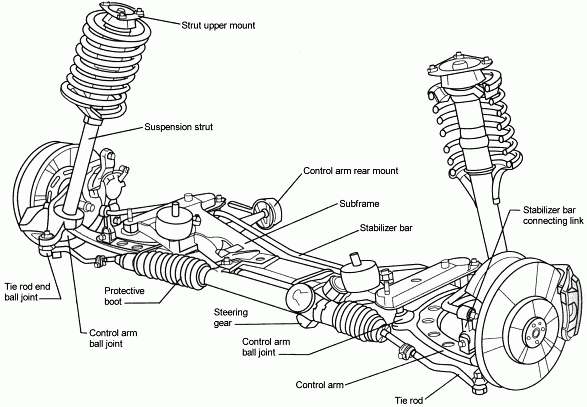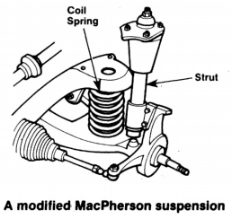Toyota uses an SAE branded suspension called Short and Long Arm, or SLA for short. The short arm in on top, the longer arm is on the bottom. This is done to make an arc with wheel travel. Toyota calls this double wishbone. Wishbone is now an industry accepted term borrowed from Honda, who used a hybrid suspension system of having traditional RWD SLA with a front wheel drive car. The wishbone was at the bottom of the damper. It is shaped like a wishbone, hence the name. This was done due to the axle needing to pass through.
The image is of a GM designed SLA, very similar to Toyota's "double wishbone".

Another popular term on the message board is coilover. This is shortened from coil over shock suspension. Having the coil over the shock makes a smoother arc. Very simple. But many older cars and some newer trucks and RWD cars use non coil over. Both are demonstated below. The first is a conventional Macpherson strut. Which I will cover in a moment.

This is called the modified Macpherson strut, used extensively by Ford on the Fox platform.

And the main difference between the shock and strut, is the upper control arm. The Macpherson strut was devoloped as a much simpler way of assembling a car and lowering weight. Most cars today use it. The strut carries a load, replacing the upper ball joint. A shock does not. The downside to the strut is limited wheel movement due to the upper mount. The car will not gain camber, that is the tire leaning out, with a strut with this limited movement.
And a shock does not absorb shock. It dampens spring oscillations. Which is why you will see the term dampers often. Even in steering. One other item is sprung and unsprung weight. Sprung weight is carried by the spring, hence the name. It is that simple. Unsprung weight is not. Such as a live axle, wheels, brakes, etc.
The image is of a GM designed SLA, very similar to Toyota's "double wishbone".

Another popular term on the message board is coilover. This is shortened from coil over shock suspension. Having the coil over the shock makes a smoother arc. Very simple. But many older cars and some newer trucks and RWD cars use non coil over. Both are demonstated below. The first is a conventional Macpherson strut. Which I will cover in a moment.

This is called the modified Macpherson strut, used extensively by Ford on the Fox platform.

And the main difference between the shock and strut, is the upper control arm. The Macpherson strut was devoloped as a much simpler way of assembling a car and lowering weight. Most cars today use it. The strut carries a load, replacing the upper ball joint. A shock does not. The downside to the strut is limited wheel movement due to the upper mount. The car will not gain camber, that is the tire leaning out, with a strut with this limited movement.
And a shock does not absorb shock. It dampens spring oscillations. Which is why you will see the term dampers often. Even in steering. One other item is sprung and unsprung weight. Sprung weight is carried by the spring, hence the name. It is that simple. Unsprung weight is not. Such as a live axle, wheels, brakes, etc.
Last edited:
